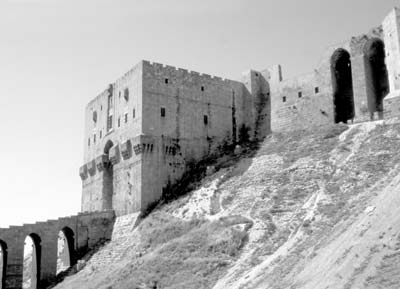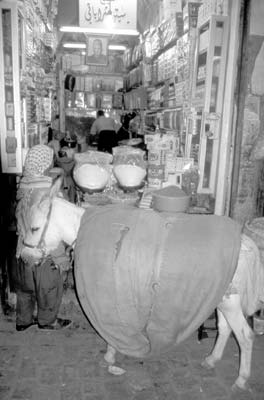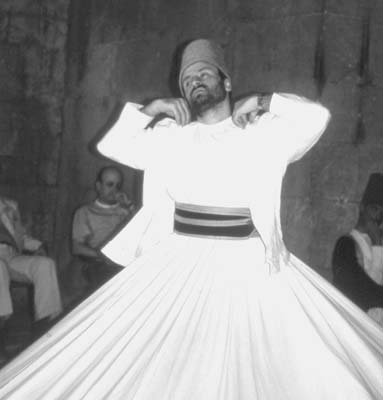The ancient Syrian city of Aleppo
by Ed Kinney
Like many cities in the Middle East, a relatively modern area surrounds the center of Aleppo, which claims to be the oldest continuously inhabited city in the world. Damascus disputes Aleppo’s claim, but who am I to argue with the antiquity claims of either?
Both are UNESCO World Heritage Sites. For this reason alone, it is unfortunate that travelers seldom visit Aleppo in northern Syria. Those who travel the monotonous road from Damascus, Syria’s capital, are rewarded when Aleppo suddenly appears — a city of buildings of wildly mixed colors surrounding a massive, 150-foot-high artificially built earthen tell with a citadel as its crown.
Aleppo radiates antiquity. It is first mentioned in Hittite documents from 2,000 B.C., though the earliest ruins uncovered go back only as far as the 10th century B.C., when neo-Hittites built a temple on this site.
The Biblical patriarch Abraham reportedly camped on this massive hilltop en route to the land of Canaan from Urfa (Turkey) long after this tell had been used as a foundation for earlier fortresses. Due to its connection with Abraham, Aleppo is called Haleb by Arabs, suggestive of the milk Abraham gave to the poor.
The city’s later history is varied, having had many conquerors, mostly Muslims, subsequent to the Crusaders’ defeat in the 12th century A.D. by Saladin, an Iraqi Kurd. Saladin’s son, al-Zaher Ghazi (reigned 1193-1215), is credited with building the current citadel’s defensive posture of crenellated walls encircling and rising above the mound’s steep slope.
The sole entry to this wonderful citadel requires climbing a steep glacis through a magnificent gate, followed by numerous sharp turns all designed to slow attackers. A ground-level surrounding moat further accents the citadel’s defensive capabilities. This design permitted Ghazi to reside safely when Aleppo was being attacked.
This citadel was later sacked twice by Mongols, and an 1822 earthquake damaged it severely. There have been later renovations.
The suq
Aleppo’s expansive suq is at the western base of the citadel. Its limestone-vaulted passages total more than 18 miles in length, making it the largest covered suq in the Middle East. I can’t corroborate this quoted size, but, from personal experience, I would suggest using a guide to avoid being hopelessly lost while exploring the suq’s maze of circuitous passageways.
Like most suqs, Aleppo’s is randomly divided into numerous smaller ones for similar-type items (clothing, spices, etc.). Also, in this suq there are khans, or areas featuring identifiable trading centers, e.g., Khan al Gumruk (khan of customs and excise), where travelers find banks and consulates. Time disappears when exploring suqs.
Near the center of this expansive suq stands the Umayyad, or Great Mosque of Aleppo, begun in A.D. 717 by Umayyad al-Walid I. Ten years earlier, al-Walid I founded the Great Mosque in Damascus, which, in my opinion, is architecturally superior.
Like many mosques, Aleppo’s has been altered following fires and raids. Its stand-alone, 150-foot-high minaret is very impressive. Interestingly, the Great Mosque in Damascus (Aug. ’02, pg. 125) has the revered head of John the Baptist, and this mosque in Aleppo reportedly has the head of his father, Zechariah, in a finely, artistically tiled chamber in the prayer hall.
Aleppo has a large Jdeide (Christian) quarter in the northern area of the Old City, mostly because Armenians emigrated or fled there in 1915 due to Turkey’s relocation policy. During travels in Syria, I’ve visited many of its Christian churches: Armenian, Maronite, Greek Orthodox and Syrian Catholic. Syria isn’t secular, but it’s also not anti-Christian.
Dervish dance
On our last night in Aleppo, to see a show a guide led my wife, Moreen, and me on a winding, 20-minute walk through the darkened passageways in the old section to a building that we later learned had been a hospital for the mentally ill in the Ottoman period.
Similar to the procedure at a speakeasy during prohibition times, our guide had to be identified before we could enter the building. Once inside, we saw a large photo of Hafez al-Assad, Syria’s (then) supreme leader, hanging on a wall. Seeing this, we relaxed, knowing that if it had al-Assad’s blessing, any ancient Syrian presentation would have government approval.
The show was typical Middle Eastern folklore until the very end. To the slow, repetitious beat of drums, two men wearing long, pleated white skirts stood up and began to spin in place. Their centrifugal force caused the skirts to flow outward smoothly.
Ice skaters may spin in place for five seconds, whereas these men spun for five continuous minutes in a seemingly semihypnotic state with their heads laid back and eyes glassy. I don’t know if they were members of an ancient whirling dervish sect or imitators.
Rivalry may exist between Syria’s two major cities, with Damascus being somewhat more cosmopolitan, if such a word exists for any Syrian city. In comparison, Aleppo reminded me of an ancient Middle Eastern city where caravans trade goods in the shadow of a protective citadel.
Minutiae
For tourist information on Syria, visit www.syriatourism.org. For other info, contact the Syrian Embassy (2215 Wyoming Ave. NW, Washington, D.C. 20008; 202/ 232-6313, www.syrianembassy.us).
Visit the Web for photos and lodging in Aleppo. We stayed in the Syrian 4-star Chahba Cham Palace Hotel. Its current room rate is $160 (probably negotiable).
Though there is no current travel warning for Syria, readers should always be observant when visiting many of the areas discussed in this column.
Coming up: personal memories of yesterday’s Middle East.



